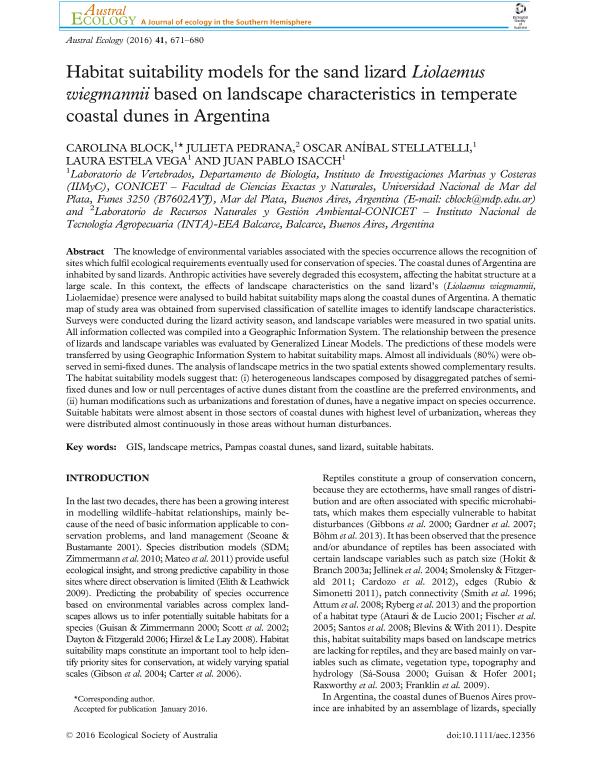Mostrar el registro sencillo del ítem
dc.contributor.author
Block, Carolina

dc.contributor.author
Pedrana, Julieta

dc.contributor.author
Stellatelli, Oscar Aníbal

dc.contributor.author
Vega, Laura Estela

dc.contributor.author
Isacch, Juan Pablo

dc.date.available
2018-08-15T22:11:13Z
dc.date.issued
2016-09
dc.identifier.citation
Block, Carolina; Pedrana, Julieta; Stellatelli, Oscar Aníbal; Vega, Laura Estela; Isacch, Juan Pablo; Habitat suitability models for the sand lizard Liolaemus wiegmannii based on landscape characteristics in temperate coastal dunes in Argentina; Wiley Blackwell Publishing, Inc; Austral Ecology; 41; 6; 9-2016; 671-680
dc.identifier.issn
1442-9985
dc.identifier.uri
http://hdl.handle.net/11336/55804
dc.description.abstract
The knowledge of environmental variables associated with the species occurrence allows the recognition of sites which fulfil ecological requirements eventually used for conservation of species. The coastal dunes of Argentina are inhabited by sand lizards. Anthropic activities have severely degraded this ecosystem, affecting the habitat structure at a large scale. In this context, the effects of landscape characteristics on the sand lizard's (Liolaemus wiegmannii, Liolaemidae) presence were analysed to build habitat suitability maps along the coastal dunes of Argentina. A thematic map of study area was obtained from supervised classification of satellite images to identify landscape characteristics. Surveys were conducted during the lizard activity season, and landscape variables were measured in two spatial units. All information collected was compiled into a Geographic Information System. The relationship between the presence of lizards and landscape variables was evaluated by Generalized Linear Models. The predictions of these models were transferred by using Geographic Information System to habitat suitability maps. Almost all individuals (80%) were observed in semi-fixed dunes. The analysis of landscape metrics in the two spatial extents showed complementary results. The habitat suitability models suggest that: (i) heterogeneous landscapes composed by disaggregated patches of semi-fixed dunes and low or null percentages of active dunes distant from the coastline are the preferred environments, and (ii) human modifications such as urbanizations and forestation of dunes, have a negative impact on species occurrence. Suitable habitats were almost absent in those sectors of coastal dunes with highest level of urbanization, whereas they were distributed almost continuously in those areas without human disturbances.
dc.format
application/pdf
dc.language.iso
eng
dc.publisher
Wiley Blackwell Publishing, Inc

dc.rights
info:eu-repo/semantics/openAccess
dc.rights.uri
https://creativecommons.org/licenses/by-nc-sa/2.5/ar/
dc.subject
Gis
dc.subject
Landscape Metrics
dc.subject
Pampas Coastal Dunes
dc.subject
Sand Lizard
dc.subject
Suitable Habitats
dc.subject.classification
Otras Ciencias Biológicas

dc.subject.classification
Ciencias Biológicas

dc.subject.classification
CIENCIAS NATURALES Y EXACTAS

dc.title
Habitat suitability models for the sand lizard Liolaemus wiegmannii based on landscape characteristics in temperate coastal dunes in Argentina
dc.type
info:eu-repo/semantics/article
dc.type
info:ar-repo/semantics/artículo
dc.type
info:eu-repo/semantics/publishedVersion
dc.date.updated
2018-08-15T13:59:18Z
dc.journal.volume
41
dc.journal.number
6
dc.journal.pagination
671-680
dc.journal.pais
Reino Unido

dc.journal.ciudad
Londres
dc.description.fil
Fil: Block, Carolina. Consejo Nacional de Investigaciones Científicas y Técnicas. Centro Científico Tecnológico Conicet - Mar del Plata. Instituto de Investigaciones Marinas y Costeras. Universidad Nacional de Mar del Plata. Facultad de Ciencia Exactas y Naturales. Instituto de Investigaciones Marinas y Costeras; Argentina
dc.description.fil
Fil: Pedrana, Julieta. Instituto Nacional de Tecnología Agropecuaria. Centro Regional Buenos Aires Sur. Estación Experimental Agropecuaria Balcarce; Argentina. Consejo Nacional de Investigaciones Científicas y Técnicas; Argentina
dc.description.fil
Fil: Stellatelli, Oscar Aníbal. Consejo Nacional de Investigaciones Científicas y Técnicas. Centro Científico Tecnológico Conicet - Mar del Plata. Instituto de Investigaciones Marinas y Costeras. Universidad Nacional de Mar del Plata. Facultad de Ciencia Exactas y Naturales. Instituto de Investigaciones Marinas y Costeras; Argentina
dc.description.fil
Fil: Vega, Laura Estela. Consejo Nacional de Investigaciones Científicas y Técnicas. Centro Científico Tecnológico Conicet - Mar del Plata. Instituto de Investigaciones Marinas y Costeras. Universidad Nacional de Mar del Plata. Facultad de Ciencia Exactas y Naturales. Instituto de Investigaciones Marinas y Costeras; Argentina
dc.description.fil
Fil: Isacch, Juan Pablo. Consejo Nacional de Investigaciones Científicas y Técnicas. Centro Científico Tecnológico Conicet - Mar del Plata. Instituto de Investigaciones Marinas y Costeras. Universidad Nacional de Mar del Plata. Facultad de Ciencia Exactas y Naturales. Instituto de Investigaciones Marinas y Costeras; Argentina
dc.journal.title
Austral Ecology

dc.relation.alternativeid
info:eu-repo/semantics/altIdentifier/doi/http://dx.doi.org/10.1111/aec.12356
dc.relation.alternativeid
info:eu-repo/semantics/altIdentifier/url/https://onlinelibrary.wiley.com/doi/abs/10.1111/aec.12356
Archivos asociados
